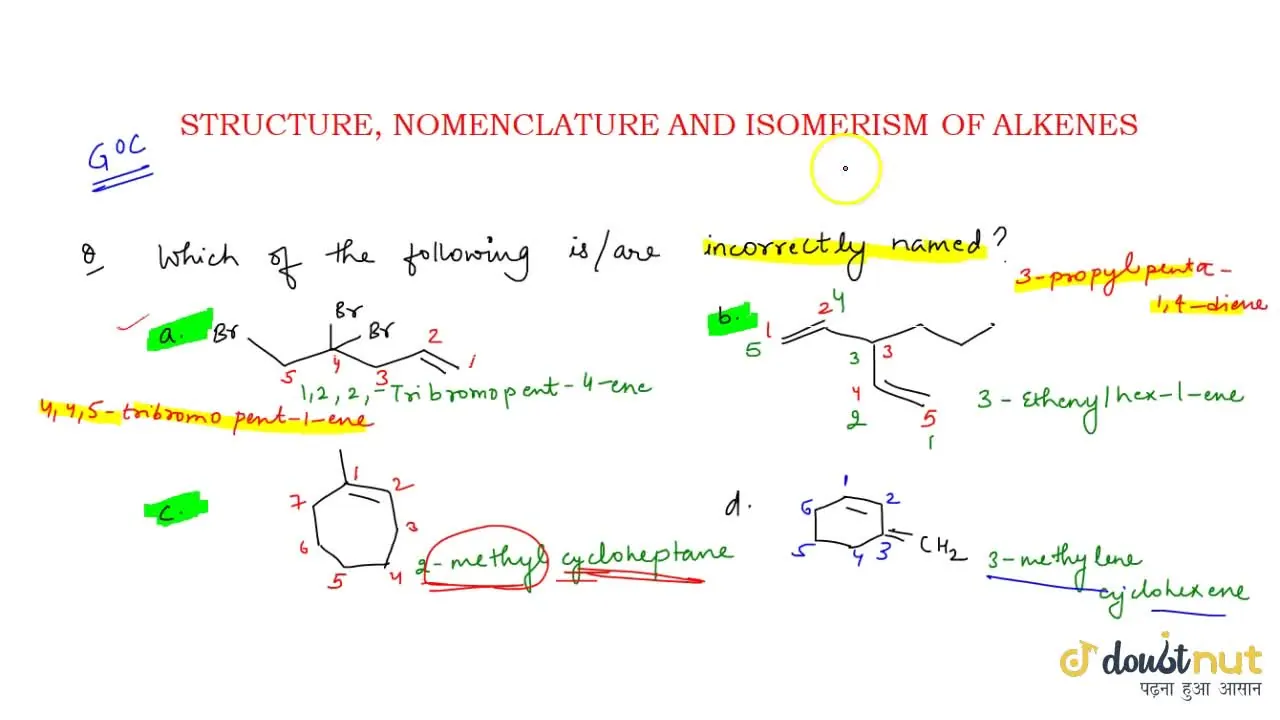STRUCTURE+NOMENCLATURE+ISOMERISM
Structure, Nomenclature, and Isomerism of Alkenes
Alkenes are hydrocarbons that have a C=C double bond. They are also known as olefins or as unsaturated compounds. They are referred to as unsaturated because the C atoms in a C=C double bond don't have enough hydrogens bonded to them as that of an alkane molecule has. Molecules having one carbon double bond are called monounsaturated compounds. Molecules with different double bonds are termed as polyunsaturated compounds.
Alkenes are the simplest compounds of the unsaturated hydrocarbons, hydrocarbons which will react with hydrogen. Alkenes contain at least one reactive double bonds between carbon atoms, and are easily represented by the symbol “=”. As we are familiar with the fact that a double bond consists of two carbon atoms. The simplest alkene is C2H4 or H2C=CH2, ethene.
The presence of a double bond is shown by the difference in completion from - ane to - ene. A more established form of the name, ethylene, is used in the chemical industry. The general formula is CnH2n. All alkenes have at any rate one double bond
Alkenes
Ethene (ethylene)
C2H4
Propene
C3H6
Butene
C4H8
Pentene
C5H10
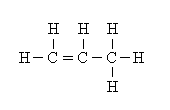
Alkenes and Cycloalkanes, both have the same general formula, CnH2n. Therefore, the general formula does not identify the structure as an alkene nor a cycloalkane.
The general formula of cycloalkenes is CnH2(n-m). The letter m implies the number of double bonds present. Thus, cyclopropene is represented by the formula C3H4 , while cyclobutene is represented by C4H6.
Nomenclature of Alkenes
Alkenes are given names using the IUPAC system. The rules for the nomenclature of alkenes are similar to that of alkanes. Let us look at the rules for alkene nomenclature.
1. Take the longest continuous carbon atom chain having carbon‐carbon double bond. The parent name of the alkene is derived from the IUPAC name for the alkane with an equal number of carbon atoms, except the suffix, ‐ane ending is changed to ‐ene to indicate double bond presence. Suppose, if the longest continuous carbon atom chain having a double bond has six carbon atoms, the compound is a Hexene.
2. Numbering the carbon atoms of the longest continuous carbon chain, starting from the end that is nearest to the double bond. Take the example of the compound depicted below. It is numbered from right to left, the position of the double bond is between the second and third carbon atoms of the chain. If the numbering would have been done from left to right, then it would have incorrectly positioned the double bond, i.e., between the third and fourth carbon.

3. The carbon double bond position is represented by putting the lowest pair of numbers assigned to the double‐bonded atoms before the alkene name. Therefore, the organic compound shown above is 2‐pentene.
4. The location and name of any substituent group is also indicated. For instance, is 5‐chloro‐2‐hexene.

5. Lastly, regarding the 3-Dimensional relationship, the cis or trans conformation label may be assigned only if the 3‐dimensional relationship is provided for the groups attached to the double‐bond carbon atoms,. Therefore, the full name of the compound above in step 4 (shown differently below in step 5) is cis‐5‐chloro‐2‐hexene.

Definition of Isomers
Molecules having the same molecular formula, but the different atomic arrangement in space, are known as isomers. It excludes any various arrangements which are simply because of the particle turning as a whole, or rotating about specific bonds.
Related Videos:
- Nomenclature And Isomerism
- Nomenclature 1
- Nomenclature 2
- Nomenclature 3
- Nomenclature Of Aryl Halide
- IUPAC Nomenclature
Types of Isomerism
There are basically two types of isomerism
- Structural Isomerism
- Geometrical Isomerism
Structural Isomerism
In this type of isomerism, the atoms making up the various isomers are aligned in a different fashion.
Geometrical Isomerism
This type of isomerism is also known as cis-trans isomerism or E-Z isomerism. Geometric isomerism is a form of stereoisomerism. In stereoisomerism, the atoms forming the isomers are aligned in the same order. However, they still manage to have a different spatial arrangement.
Isomerism in Alkenes
Alkenes exhibit both structural isomerism and geometrical isomerism.
Structural Isomerism
Ethene and propene have only one chemical structure. Alkenes higher than propene have different structures. Let us consider the example of C4H8, the three structural isomers are:
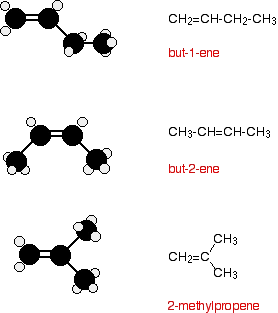
Geometrical Isomerism
The double-bond of carbon atoms does not allow any rotation about it. Therefore, it makes it possible to have the CH3 groups on any one end of the molecule attached either on the side of the molecule or opposite to each other.
These are referred to as cis-but-2-ene (same side) or trans-but-2-ene (opposite sides).
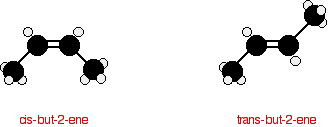
The most common example of geometric isomerism is but-2-ene. In one scenario, the CH3 groups are located on opposite sides of the double bond, and in the other scenario, the CH3 groups are located on the same side.
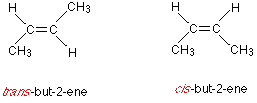
Geometric Isomerism effect on Physical Properties
The following table depicts the boiling point and melting point of the cis and trans isomers of 1,2-dichloroethene.
Isomer
boiling point (°C)
melting point (°C)
cis
60
-80
trans
48
-50
In the above case, you will observe that:
the trans isomer of 1,2-dichloroethene has a higher melting point;
the cis isomer of 1,2-dichloroethene has a higher boiling point.
It is typical.
Now let us see the same effect with the cis and trans isomers of but-2-ene:
Isomer
boiling point (°C)
melting point (°C)
cis-but-2-ene
4
-139
trans-but-2-ene
1
-106
Reason for the higher boiling point of the cis isomers than trans isomers
There would be a stronger intermolecular force between the cis isomers molecules than in those of trans isomers.
For example: 1,2-dichloroethene
Both of the isomers have the very same atoms arranged in the same order. Therefore, the intermolecular van der Waals dispersion forces will be the same in the two cases. The difference between is that the cis isomer is a polar atom. In contrast, the trans isomer is a non-polar atom.
Important Chapters:
Alkenes
Ethene (ethylene)
C2H4
Propene
C3H6
Butene
C4H8
Pentene
C5H10







Isomer
boiling point (°C)
melting point (°C)
cis
60
-80
trans
48
-50
Isomer
boiling point (°C)
melting point (°C)
cis-but-2-ene
4
-139
trans-but-2-ene
1
-106
Similar Questions
Conjugation OF Resonating structure|| Types OF Conjugation|| Rules OF R/S Nomenclature
View SolutionOrganic Compound|Question|Structural Representations Of Organic Compounds|Classification Of Organic Compounds|Nomenclature Of Organic Compounds|The IUPAC System Of Nomenclature|IUPAC Nomenclature Of Alkane|Summary
View SolutionOrganic Compound|Question|Structural Representations Of Organic Compounds|Classification Of Organic Compounds|Nomenclature Of Organic Compounds|The IUPAC System Of Nomenclature|IUPAC Nomenclature Of Alkane|Summary
View SolutionOrganic Compound|Question|Structural Representations Of Organic Compounds|Classification Of Organic Compounds|Nomenclature Of Organic Compounds|The IUPAC System Of Nomenclature|IUPAC Nomenclature Of Alkane|Summary
View SolutionImportant Terms|Structural Formula|Classification Of Organic Compounds|IUPAC Nomenclature Of Organic Compounds|Summary
View SolutionIUPAC Nomenclature OF geometrical Isomeric Compound||Syn-Anti Conformation|| E-Z Nomenclature
View SolutionIUPAC Nomenclature OF Geometrical Isomeric Compound||Cis-Trans isomer||Introduction OF CIP rule
View SolutionIntroduction To Organic Chemistry - Structural Isomerism 2
View SolutionIntroduction To Organic Chemistry - Structural Isomerism - Tautomerism
View SolutionIntroduction To Organic Chemistry - Structural Isomerism 1
View Solution

